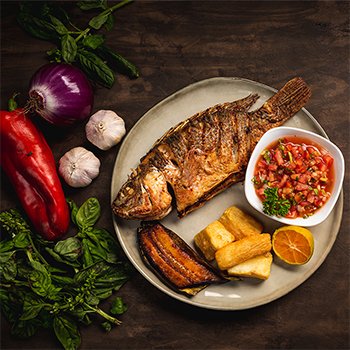บทบาทและความท้าทายของการประมงไทยสู่ทิศทางอาหารเพื่อสุขภาพ Roles and Challenges in Fisheries of Thailand to Healthy Food Trends
1489 Views |

บทบาทและความท้าทายของการประมงไทยสู่ทิศทางอาหารเพื่อสุขภาพ Roles and Challenges in Fisheries of Thailand to Healthy Food Trends
By: ดร. นรธัช ประชุม
Noratat Prachom, Ph.D.
Fish Feed Technology Development Center
Department of Aquaculture, Faculty of Fisheries
Kasetsart University
noratat.p@ku.th
สัตว์น้ำ คือ ผลผลิตจากการประมงซึ่งประกอบด้วย (1) การจับจากธรรมชาติ และ (2) การเพาะเลี้ยง ซึ่งการประมงทั้งสองแบบนี้มีบทบาทสำคัญต่อเศรษฐกิจและความมั่นคงทางอาหารของประเทศไทย แม้ว่าประเทศไทยเป็นประเทศที่มีความอุดมสมบูรณ์ของทรัพยากรธรรมชาติ และเป็นประเทศผู้ผลิตอาหารที่สำคัญในภูมิภาคเอเชียตะวันออกเฉียงใต้ แต่ปริมาณผลผลิตสัตว์น้ำที่มาจากการจับจากธรรมชาติยังไม่ตอบโจทย์ความต้องการในการบริโภค ส่งผลให้การเพาะเลี้ยงสัตว์น้ำเข้ามามีบทบาทสำคัญในการผลิตสัตว์น้ำเพื่อเติมเต็มความต้องการทั้งการบริโภคภายในประเทศและการส่งออก อันจะนำมาซึ่งรายได้ให้กับประเทศไทย โดยเฉพาะสัตว์น้ำที่มีมูลค่าสูงและเป็นที่นิยมในการบริโภค อย่างกุ้งขาวแวนนาไม โดยการเพาะเลี้ยงสัตว์น้ำถูกแบ่งออกเป็น 2 รูปแบบ คือ (1) การเพาะเลี้ยงสัตว์น้ำจืด และ (2) การเพาะเลี้ยงสัตว์น้ำชายฝั่ง ในประเทศไทย การเพาะเลี้ยงสัตว์น้ำส่วนใหญ่นิยมเลี้ยงในบ่อดินหรือในกระชัง ซึ่งการผลิตสัตว์น้ำเศรษฐกิจหลัก 3 อันดับแรกของไทย ได้แก่ กุ้ง ปลา และหอย
จากประมาณการจำนวนประชากรโลกจะเพิ่มขึ้นมากถึง 10,000 ล้านคนในปี พ.ศ. 2593 หรือในอีก 27 ปีข้างหน้านี้ ส่งผลให้ความต้องการอาหารเพิ่มขึ้นถึงร้อยละ 52 โดยเฉพาะอย่างยิ่งความต้องการของแหล่งโปรตีน กล่าวคือ ในอุตสาหกรรมผลิตอาหารของโลกต้องเพิ่มกำลังการผลิตและปริมาณการผลิตจากปัจจุบันอีกร้อยละ 52 จากการรายงานผลการศึกษาต่างๆ พบว่า การผลิตสัตว์น้ำส่งผลกระทบต่อสิ่งแวดล้อมน้อยกว่าการปศุสัตว์ชนิดอื่นๆ ยกตัวอย่างเช่น การผลิตปลา 1 กิโลกรัม สามารถปลดปล่อยก๊าซเรือนกระจกเพียงแค่ 3 กิโลกรัมคาร์บอนไดออกไซด์ ซึ่งน้อยกว่าการเลี้ยงสุกร 2 เท่า (6 กิโลกรัมคาร์บอนไดออกไซด์ต่อกิโลกรัมสุกร) และน้อยกว่าการเลี้ยงโคเนื้อถึง 10 เท่า (30 กิโลกรัมคาร์บอนไดออกไซด์ต่อกิโลกรัมโคเนื้อ)
Food fishes are the product of the fishery. In addition, the fishery has two types of activity: (1) capture fishery and (2) culture fishery. Fisheries and aquaculture play a significant role in food security and the economy of Thailand. However, Thailand is one of the natural and water resources richness countries in the Asia-Pacific region. The yield from capture fisheries is not increased to satisfy the increasing demand for consumption. As a consequence, aquaculture is a solution and has long-term potential for increasing fisheries production for both local consumption and export, as well as for achieving country incomes from high-value cultured aquatic species, such as white shrimp (Penaeus vannamei). Aquaculture in Thailand can be divided into two categories: (1) Inland freshwater aquaculture and (2) Coastal aquaculture. Aquaculture, manly earthen pond or cage culture, has been practiced in Thailand. The three main aquaculture products are shrimps, finfish, and mollusks.
The global population has been estimated to be 10 billion in 2050. Consequently, the demand for food and protein will increase by about 52% of the current production. Therefore, all food industries might need to increase their production and capacity (about 52%). Although aquaculture has lower carbon dioxide emission (carbon footprint of about 3 kilograms CO2/kilogram) than most livestock, such as swine production (6 kilograms CO2/kilogram of pig) and cattle beef production (30 kilograms CO2/kilogram of beef).






